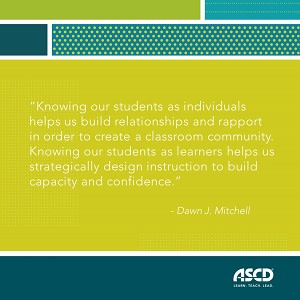In times of crisis, a natural reaction or coping mechanism we may have is to run and hide. This is a natural flight response to an unknown situation. We are in survival mode, overwhelmed by emotions we cannot yet convey, and because of that, it may be a challenge to think rationally.
How do we get to a place in which we can adopt a mindset to keep things simple and streamlined and still meet our own needs, as well as those of our students? Perhaps this is the time to adopt a minimalist mindset to simplify life, find more peace and order, manage reactions, and work through the uncertainty and stress.
- Reflect on your role or goal. Being thoughtful and astute about what role you will play during this time of crisis is essential to understanding where your time and effort needs to be. In the best of times, teachers wear multiple hats and are required to be many things to many people. But these times of crisis are in no way the best of times. We will need to be deliberate and focused so as not to overwhelm ourselves.
- Step away from the device! Choose two or three trusted news sources to rely on for your information. We tend to immediately grab our phones, send rapid-fire text messages, and soothe ourselves with any kind of information. We have become natural consumers of endless media reporting about frightening events we may not understand. Reading too many articles may result in irrational behaviors like hoarding items, whether we need them or not. Choosing trusted sources and limiting intake will help you when your students have questions about the situation.
- Make two to-do lists. Create one list that focuses on your family or close social circle and one that focuses on your teaching or school life. This will calm your panic mode and slow down your decision-making process. Immediate decisions are often ones based on emotion, and in times of crisis, decisions must be made through reason. A clear list sorts through the chaos and can make you feel more in control.
- Find the most direct ways to communicate with your community. What are the tools you already have in place that can address the needs of the whole group? Use what’s familiar and choose one or two tools that you know all families can access. Maybe it’s Google Classroom or a parent WhatsApp group. Familiarity is an effective jumping off point to maintain communication and a sense of community.
- Gather a few multi-functional resources to continue teaching. Distinguish between an actual need and what you think you need. Gather resources that can be used for multiple purposes for multiple learning sessions, such as picture books and a small whiteboard and marker. Keep in mind that the people in your life are your priority. This will help you keep the ‘needs’ list simple.
Disruptions to established school routines may lead to concerns about loss of student learning or the delay in curriculum delivery. Take a moment to remind yourself that teachers will do what we have always done. We will continue to do what is central to our job, which is to evaluate where our students are at in their development and find ways to move them forward. Adopting a minimalist mindset during challenge is a journey from which we can all learn and grow. Be willing to share your journey and support others in reframing thinking in a time when we all need it most.








